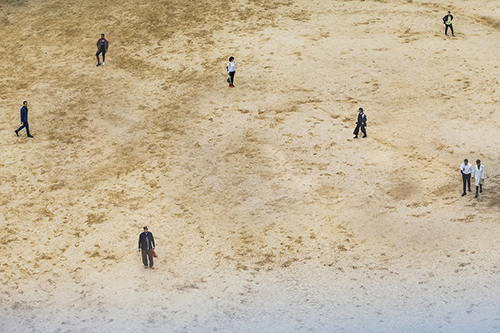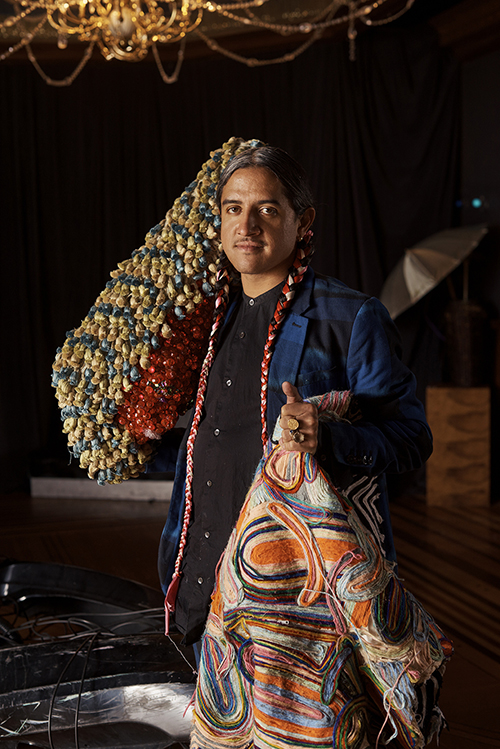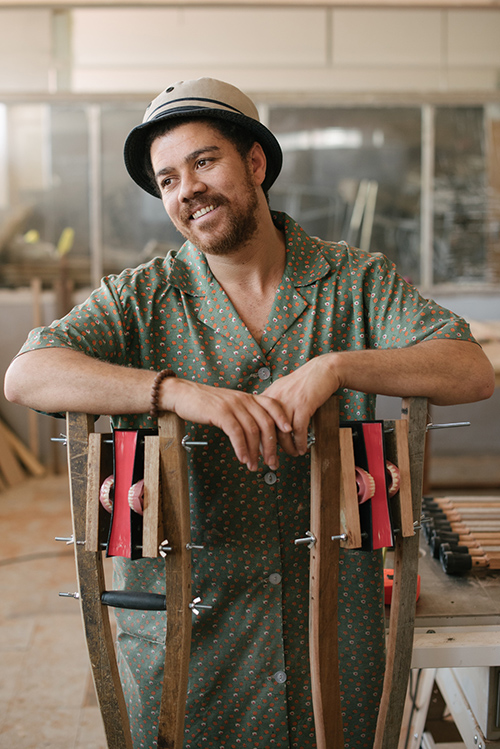Portrait of Raúl de Nieves in his Queens studio by Alex John Beck for Artsy.
The bold, transcendent work of Mexico-born, New York-based de Nieves is rocketing to prominence. His intricate sculptures and body-quaking performances featured in MoMa PS1’s influential roundup of regional emerging art, Greater New York. And the remainder of 2016 saw de Nieves’s work heralded for group shows at prominent galleries like Gavin Brown’s enterprise, and solo presentations at COMPANY gallery’s Lower East Side space and booth at NADA Miami. Across each venue, de Nieves’s intricately beaded sculptures explore the fine lines between violence and beauty, pleasure and sacrifice, anger and devotion. They feature impossibly high platform shoes encrusted in jewel-like bits of plastic, military backpacks embellished with pearls, and full-body suits covered completely in beads. Similarly, his performances, both alone and with his band Haribo, see him dressed flamboyantly in psychedelically hued costumes and screaming at the top of his lungs, like a heavy-metal front man.
The coming year promises even more exposure for the artist’s spellbinding practice, which explores the intersection of self-expression, sexual freedom, and cultural ritual. Influenced by his Mexican roots and his New York community alike, de Nieves’s installations often resemble a hybrid of a Día de los Muertos celebration and a downtown club. Up next for the multidisciplinary artist: the 2017 Whitney Biennial, and a performance with Colin Self at The Kitchen. “The vibrancy and infectious energy Raúl brings to every single aspect of his work is really inspiring,” says Whitney Biennial 2017 co-curator Mia Locks. “Whether in sculpture or performance or installation, his work invokes a real labor of love and a generosity of spirit that feels ever more important in these troubling times.”
Mario Pfeifer
B. 1981, DRESDEN, GERMANY • LIVES AND WORKS IN BERLIN AND NEW YORK
Portrait of Mario Pfeifer in Mexico City by Ana Hop for Artsy.
Location is key for German artist and filmmaker Pfeifer, known for culturally sensitive and research-intensive video works. Over recent years, Pfeifer has traveled to the southernmost tip of South America to document the indigenous people of Tierra del Fuego, to the streets of Brooklyn to create a music video with the Flatbush ZOMBiES, to the urban chaos of São Paulo to film crystal healers and other religious leaders, and to his native East Germany, where he interviewed members of the far-right PEGIDA movement. “His videos are politically committed and at the same time characterized by an almost anthropological view,” notes Kunsthalle Wien curator Vanessa Joan Müller, who recently contributed an essay to one of Pfeifer’s catalogues. “He observes cultural upheavals from an interested distance and transforms his impressions into fascinating films that deconstruct exoticism in favour of insight.”
His 2015 collaboration with the ZOMBiES titled #blacktivist has resulted in nearly 3 million YouTube views—and resounding praise for the artist. The resulting two-channel video installation debuted at Goethe-Institut’s New York space, Ludlow 38, and went on to feature at this year’s editions of The Armory Show and Art Cologne, and at Berlin’s ACUD theater. This fall, Pfeifer opened his first comprehensive institutional solo exhibition, curated by Kirsa Geiser at the Museum of Contemporary Art Leipzig, featuring the 10-part film resulting from his time in São Paulo in which he documents the varied religious rituals of Brazil’s diverse population. Currently Pfeifer is in Mexico City, researching developments in virtual reality and robotics, a project that will take him on to Johannesburg, Beirut, Seoul, and Ulaanbaatar. Pfeifer’s momentum carries into 2017 with group exhibitions at Paris’s Maison Populaire and Lisbon’s MAAT, as well as a third solo show with KOW in Berlin.
Donna Huanca
B. 1980, CHICAGO • LIVES AND WORKS IN BERLIN AND NEW YORK
Portrait of Donna Huanca in her Berlin studio by Jonas Lindström for Artsy.
Thirty-six-year-old artist Huanca has long taken skin and the human body as her medium—from imprints of paint-daubed performers à la Yves Klein, to performances featuring trancelike nude models clad head-to-toe with pigment, clay, and bodystockings. But this year saw her practice reach new heights. In addition to a September solo at Peres Projects, a performance at Manifesta 11, and a handful of group exhibitions, Huanca tied up the year with her first U.K. solo at the Zabludowicz Collection—notably, the space’s first performance-focused commission.
The exhibition kicked off during Frieze Week in London, filling the collection’s 19th-century chapel with stunning sculptural installations swarmed by a gang of glacially moving, painted performers (she calls them collaborators). Amidst the scent of Palo Santo—a wood tied to sacred and shamanic rituals—they moved through the space, lulling runaway fairgoers into a brilliantly meditative state. The show’s curator, Maitreyi Maheshwari, says Huanca’s work “provokes a mixture of devotion from her collaborators and a visceral discomfort from her audience as we are asked to confront our attitudes to the body and all the power dynamics attendant to it.” These include, among others, looking and being looked at, gender, race, sexuality, and objectification. “She has a very clear vision of what she wants her work to do, and is very open to working with others in order to make that vision a reality,” says collector, philanthropist, and Zabludowicz Collection co-founder Anita Zabludowicz.
Kemang Wa Lehulere
B. 1984, CAPE TOWN • LIVES AND WORKS IN CAPE TOWN
Portrait of Kemang Wa Lehulere in his Cape Town studio by DNA Photographers for Artsy.
South African artist Wa Lehulere’s year wrapped up with a series of firsts—his first U.K. solo exhibition at Gasworks in September, his first American museum show at the Art Institute of Chicago in October—and the streak continues into 2017. The 32-year-old’s first German institutional solo show will go on view at Berlin’s Deutsche Bank KunstHalle in the spring, celebrating his tenure as Deutsche Bank’s 2017 Artist of the Year. This marks the acceleration of a long-standing art world interest in Wa Lehulere’s work, which previously appeared in the Berlin and Lyon Biennials and the 2012 New Museum Triennial.
Wa Lehulere uses a wide range of mediums to craft historical narratives of his native country that are at once collective and personal. His Art Institute show featured porcelain dog sculptures alongside suitcases brimming with grass, chalk drawings of pencil sharpeners and musical scores, and a video of a cigarette slowly turning to ash. To underscore the slippery and ephemeral nature of recollection, he often incorporates symbols of rehearsal (music stands, empty stages) and education (wooden desks, blackboards). “Kemang wields familiar, often fleeting materials with sensitivity and specificity,” says Kate Nesin, associate curator of modern and contemporary art at the Art Institute. “While his work tends to excavate lost histories, I find it is less about the past than about both the present and the future—not just what we remember but also what we rehearse, and what we rehearse for.”
Anne Imhof
B. 1978, GIESSEN, GERMANY • LIVES AND WORKS IN FRANKFURT, GERMANY
Portrait of Anne Imhof in her Frankfurt studio by Nadine Fraczkowski.
Shortly after Imhof’s solo shows at the Hamburger Bahnhof and Kunsthalle Basel
came to a close this year, it was announced that the 38-year-old artist would represent Germany in the 2017 Venice Biennale. The news galvanized a momentous year for Imhof, whose performances, paintings, and installations dissect contemporary culture—in particular, how branding, technology, and power structures shape us as humans. In one canvas, The Navel (2016), currently on view at the Rubell Family Collection in Miami, a portrait of a young woman shaving her stomach floats in space not far from a can of Diet Coke, connecting millennial identity to the consumer goods that surround us.
“Performance has a now-long history, but Anne Imhof’s take on performance renders it both percussively critical and squarely of our time,” explains Kunsthalle Basel curator Elena Filipovic, who organized Imhof’s solo show, titled “Angst,” this summer. “She makes truly epic work (and I don’t use that term lightly) that brings together an almost ceremonial rituality and an extreme conception of the experience of time with subcultural references and coded gestures—whether a runway march or head banging, utter dependence on an iPhone, or drinking Diet Pepsi.” Indeed, as the title of Imhof’s Kunsthalle Basel show suggests, her work powerfully synthesizes a host of contemporary cultural norms and anxieties in order to shine a light on how they affect relationships and human nature itself.
Rachel Rossin
B. 1987, WEST PALM BEACH, FLORIDA • LIVES AND WORKS IN BROOKLYN, NEW YORK
Portrait of Rachel Rossin in her Brooklyn studio by Alex John Beck for Artsy.
Rossin began experimenting with computer code at the tender age of age eight. And, recently, she has been hailed as one of the pioneers of the burgeoning artistic medium of virtual reality. The New York-based artist skillfully manipulates digital technology to create immersive environments where one might fall through the center of the world as gravity dissipates or drift through the artist’s digitally distorted home and studio like a ghost—all seen through the Oculus Rift headset, which she’s tinkered with since receiving a developer prototype before its official launch in spring 2016.
Rossin has been increasingly gaining traction following two well-received New York solo shows in 2015—“n=7 / The Wake in Heat of Collapse” at SIGNAL and “Lossy” at ZieherSmith—both of which featured virtual reality-based works, often in conversation with her paintings and sculptures. She was also selected as the New Museum’s first-ever virtual reality fellow, a program she wrapped up in 2016 under the purview of the museum’s incubator NEW INC.
“She’s one of those rare artists who is seemingly devoid of ego and pretension, who exudes genuine and uninhibited curiosity, and radiates warmth and light,” says Julia Kaganskiy, director of NEW INC. “I think this may be the reason why she’s able to move between worlds, contexts, and media so deftly, alternating between wielding a paintbrush or VR headset, and offering subtle but poignant images and observations that illuminate and inspire both vantage points.” Rossin’s work has continued to captivate audiences at the 2016 editions of SPRING/BREAK Art Show, NADA New York, UNTITLED, Miami Beach, and Seattle Art Fair; and during Art Basel in Miami Beach week, fair-goers visiting the brand new Faena Art Dome experienced her project commissioned by Artsy, using 360° projection to bring virtual reality out of the headset.
Cécile B. Evans
B. 1983, CLEVELAND, OHIO • LIVES AND WORKS IN LONDON AND BERLIN
Portrait of Cécile B. Evans by Yuri Pattison, courtesy of the artist.
With digital avatars, robots, and animated video that presage a cyborg-filled future, Evans has poignantly plumbed the relationship between humans and machines that has come to define our contemporary world. The Belgian-American artist began to catch the art world’s eye in 2014 with her first solo gallery show at London’s Seventeen, and a digital commission for Serpentine Galleries (the first ever) which manifested as a 16-year-old spambot named Agnes. But this year was a defining one for Evans. Her work was the undisputed standout of the buzzy Berlin Biennale and is currently on view, until March 2017, in a solo show at Tate Liverpool.
“Cécile’s work unravels the value of emotion in our contemporary society, and the person-to-machine exchanges that have come to define the contemporary human condition,” explains the art collective DIS, who curated the Berlin Biennale. Evans created three new works for the exhibition, including the show-stealing video What the Heart Wants (2016). As lab children coddled by robot caregivers and a memory from 1972 which has outlived its human creators pass across the screen, Evans hypothesizes how machines will continue to transform what it means to be human.
Christopher Kulendran Thomas
B. 1979, LONDON • LIVES AND WORKS IN LONDON AND BERLIN
Portrait of Christopher Kulendran Thomas in Berlin by Jonas Lindström for Artsy.
The week before the U.S. presidential election, 37-year-old artist Kulendran Thomas opened a show at Hamburg’s Kunstverein Harburger Bahnhof titled “60 million Americans can’t be wrong.” The show opened with a question: “Could this U.S. Presidential election even constitute a revolutionary attempt by the demographically disenfranchised?” Pundits in the time since have responded, resoundingly, yes. The exhibition centers on Kulendran Thomas’s startup-as-artwork New Eelam (2016), which debuted at the Berlin Biennale this summer and proposes a future in which globetrotting subscribers to the service collectively own and occupy hiply furnished homes in cities around the world, while referencing the proposed state of Tamil Eelam, which was wiped out during Sri Lanka’s 26-year civil war, often characterized as a genocide.
New Eelam is as much a globalist’s dream as it is a very symptom of the hyper-globalization that those 60 million Americans rallied successfully against on November 8th. It toured the world in various forms this year, making stops at the 11th Gwangju Biennale, the Dhaka Art Summit, and the Museum of Modern Art in Warsaw, in addition to Berlin and Hamburg, garnering unprecedented attention for the London-born and -based artist. (In 2017, he’ll enjoy further shows at the Hamburger Bahnhof in Berlin and Tensta Konsthall in Stockholm.) The work continues Kulendran Thomas’s practice, which often takes an active role in trying to reshape or reformulate the core structures of our world rather than critique them. “Christopher’s approach to art and politics is different from most. He is perpendicular to the left,” comments Marco Roso of the New York collective DIS, which curated the Berlin Biennale. “Christopher works t











